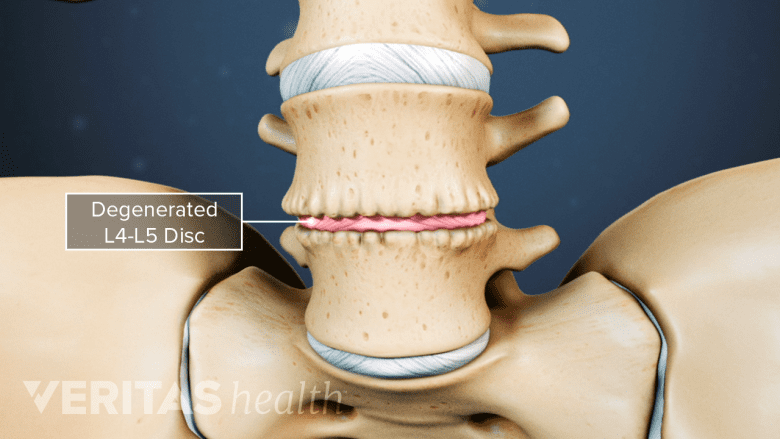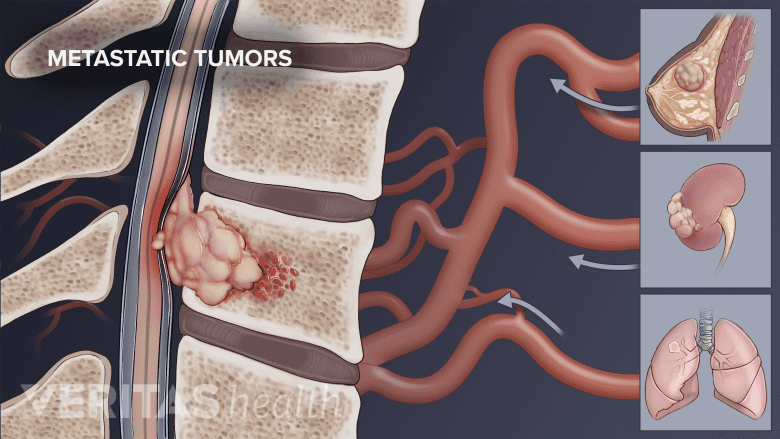There are many possible causes of lower back pain, including damage to the intervertebral discs, compression of nerve roots, spinal joint friction, and muscle strains and spasm.
This guide provides in-depth information on many causes of low back pain, with links to further information as needed.
Let’s start with the single most common cause of low back pain -- a torn or pulled back muscle and ligament.
In This Article:
A Pulled or Strained Back Muscle
A low back sprain or strain can happen suddenly, or can develop slowly over time from repetitive movements.
- Strains occur when a muscle is stretched too far and tears, damaging the muscle itself.
- Sprains happen when over-stretching and tearing affects ligaments, which connect the bones together.
For practical purposes, it does not matter whether the muscle or ligament is damaged, as the symptoms and treatment are the same.
Watch Lower Back Strain Video
Common causes include:
- Lifting a heavy object, or twisting the spine while lifting
- Sudden movements that place too much stress on the low back, such as a fall
- Poor posture over time
- Sports injuries, especially in sports that involve twisting or large forces of impact
While a pulled muscle does not sound serious and does not typically cause long-lasting problems, the acute pain can be debilitating.
Common Causes of Chronic Lower Back Pain
Pain is considered chronic once it lasts for more than three months and exceeds the body’s natural healing process. Chronic pain in the low back is often caused by a disc problem, endplate damage, a joint problem, and/or an irritated nerve root, such as:
Lumbar herniated disc
The soft inner core of a spinal disc can break through the tough outer layer and irritate a nearby nerve root. A lumbar herniated disc typically causes pain through two mechanisms:
- The herniated portion of the disc contains proteins that cause inflammation when they get near a nerve root
- The portion of the disc that herniates through the disc wall can compress, or “pinch”, the nearby nerve root
A herniated disc may cause low back pain with or without leg pain, typically referred to as sciatica or radicular pain.
See Treatment for a Lumbar Herniated Disc
Degenerative disc disease

Intervertebral discs may undergo degeneration, leading to pain disc herniation.
As people age and spinal discs are stressed over time, they tend to lose hydration and wear down. As the disc loses hydration, it cannot resist forces as well, and the disc wall tends to weaken develop tears. Lumbar degenerative disc disease is thought to cause pain through two mechanisms:
- Inflammation in and around the disc and adjacent nerves
- Micromotion as the spinal segment becomes more unstable.
As the disc degenerates and loses function, it can also lead to further spinal conditions such as spondylolisthesis, facet joint osteoarthritis, spinal stenosis, vertebrogenic pain, and/or a herniated disc.
A general term for degenerative disc disease is discogenic pain, which means pain that is caused by the disc itself.
Watch Lumbar Degenerative Disc Disease Video
Facet joint dysfunction
There is a pair of facet joints behind each disc at each motion segment in the lumbar spine. These joints have cartilage between the bones and are surrounded by a capsular ligament, which is rich with nerves. Facet joints can degenerate and become painful (facet joint osteoarthritis), or they can be a source of pain in conjunction with disc pain (discogenic pain).
See Facet Joint Disorders and Back Pain
Sacroiliac joint dysfunction

The sacroiliac joint functions as a shock-absorbing joint between the upper and lower body.
The sacroiliac joint connects the sacrum at the bottom of the spine to the hip bone on each side. It is a strong, low-motion joint that primarily absorbs shock and tension between the upper body and the lower body. The sacroiliac joint can become painful if:
- The SI joint becomes inflamed, called sacroiliitis
- There is too much or too little motion of the joint, called sacroiliac joint dysfunction
Watch Sacroiliac Joint Dysfunction Video
Vertebrogenic pain
The vertebral endplates are sandwiched between each end of the spinal disc and the adjacent vertebra (the bony building blocks of the spine). These endplates connect the disc to the bone. They have a rich supply of blood vessels and nerve fibers, and when the endplate becomes damaged, it can become a source of lower back pain called vertebrogenic pain.1Lotz JC, Fields AJ, Liebenberg EC. The role of the vertebral end plate in low back pain. Global Spine J. 2013;3(3):153-164. doi:10.1055/s-0033-1347298
Watch Vertebrogenic Low Back Pain Animation
Spinal stenosis
Lumbar spinal stenosis causes pain through narrowing of the spinal canal where the lumbar nerve roots are located. The narrowing tends to cause pain and/or weakness in the legs, and spinal stenosis symptoms vary depending on which level or levels of the spine are affected.
Spondylolisthesis

Spondylolisthesis may cause spinal instability and potential compression of nerves.
This condition occurs when one vertebra slips over the adjacent one. There are 5 types of spondylolisthesis but the most common are secondary to a defect or fracture of the pars (between the facet joints) or mechanical instability of the facet joints (degenerative). The pain felt in the lower back is due to instability, and pain and/or weakness is felt in the legs if there is nerve compression. This condition is common at the L5-S1 level.
Osteoarthritis

Osteoarthritis pain is caused by gradual wear and tear of facet joints.
Spinal arthritis is typically caused by wear and tear of the disc and facet joints over a long period of time. The condition is marked by low back pain, inflammation, spinal instability, and potentially stenosis. It can occur at a single level or multiple levels of the lower spine. Spinal osteoarthritis is associated with aging and is slowly progressive. It is sometimes called spondylosis or degenerative joint disease.
Deformity

Scoliosis leads to triggering muscle spasms and lower back pain.
The curvature of the spine can include scoliosis or kyphosis. The deformity may be associated with lower back pain if it leads to the breakdown of the discs, facet joints, sacroiliac joints, or stenosis.
Trauma
Acute fractures or dislocations of the spine can lead to pain. Lower back pain that develops after a trauma, such as a motor vehicle accident or a fall, should be promptly medically evaluated.
Vertebral fracture
A fracture can occur in the cylindrical vertebra, in which the bone essentially caves in on itself, and this is called a compression fracture or vertebral fracture. Primary symptoms of vertebral fracture are sudden pain and possibly deformity that looks like a hunched back. This type of fracture is most common due to weak bones, such as from osteoporosis.
Watch Spinal Compression Fracture Video
Spinal infection
One spinal infection is osteomyelitis, and it is rare but can cause a lot of pain and is life-threatening if untreated. Osteomyelitis can be caused by surgical procedures, injections, or spread through the bloodstream. Patients with a compromised immune system are more susceptible to developing this type of infection in the spine. The spinal disc can also become infected, and this is called discitis. This type of infection can develop on its own or after surgery.
Infectious diseases
Certain types of infectious disease sometimes have lower back pain as a prominent symptom. Examples of these types of infection include Lyme disease and bartonella.2Govil S, Capitle E, Lacqua A, Khianey R, Coyle PK, Schutzer SE. Common Neurologic Features of Lyme Disease That May Present to a Rheumatologist. Pathogens. 2023;12(4):576. Published 2023 Apr 9. doi:10.3390/pathogens12040576,3Bartonella infections | cdc yellow book 2024. Available from https://wwwnc.cdc.gov/travel/yellowbook/2024/infections-diseases/bartonella-infections. Last updated May 01, 2023.
Tumor

Metastatic spinal tumors can cause a range of general and low back symptoms
Most spinal tumors start in another part of the body and metastasize to the spine. The most common tumors that spread to the spine start from cancer in the breast, prostate, kidney, thyroid, or lung. Any new symptoms of back pain in a patient with a known diagnosis of cancer should be evaluated for possible spinal metastasis.
Watch Metastatic Spinal Cancer Video
Autoimmune disease
Back pain is a possible symptom associated with autoimmune conditions, such as ankylosing spondylitis, rheumatoid arthritis, lupus, Crohn’s disease, fibromyalgia, and others.
It is important to note that the presence of one or more of these conditions does not necessarily mean that it is the cause of pain. For example, osteoarthritis or degenerative disc disease could appear on an imaging study, but the person may not report pain.
Referred Pain
Low back pain can also be referred by another part of the body. Common examples of disorders that can refer pain to the lower back include:
- Appendicitis
- Abdominal aortic aneurysm
- Kidney stones or infection
- Bladder infections
- Gynecological problems, such as pelvic infections or ovarian cysts
- Hip conditions, such a hip labral tears, frozen hip, or hip impingement
Obtaining a correct clinical diagnosis that identifies the underlying cause of the symptoms is a necessary first step to engaging in a successful course of treatment.
- 1 Lotz JC, Fields AJ, Liebenberg EC. The role of the vertebral end plate in low back pain. Global Spine J. 2013;3(3):153-164. doi:10.1055/s-0033-1347298
- 2 Govil S, Capitle E, Lacqua A, Khianey R, Coyle PK, Schutzer SE. Common Neurologic Features of Lyme Disease That May Present to a Rheumatologist. Pathogens. 2023;12(4):576. Published 2023 Apr 9. doi:10.3390/pathogens12040576
- 3 Bartonella infections | cdc yellow book 2024. Available from https://wwwnc.cdc.gov/travel/yellowbook/2024/infections-diseases/bartonella-infections. Last updated May 01, 2023.

